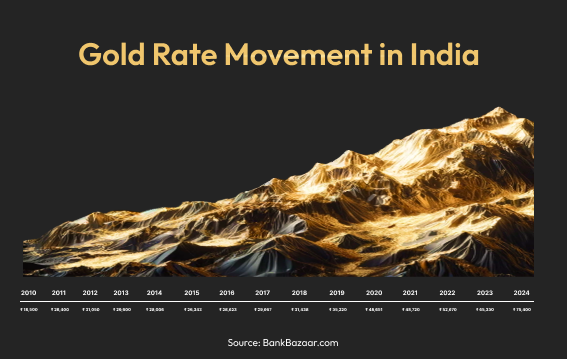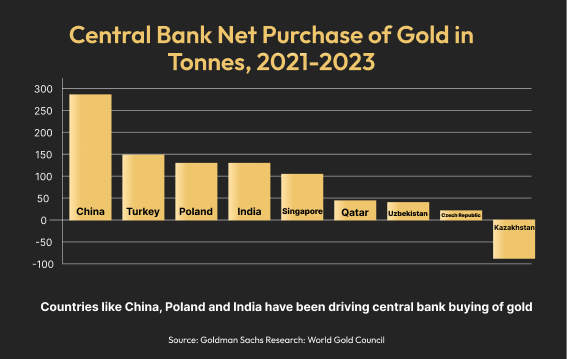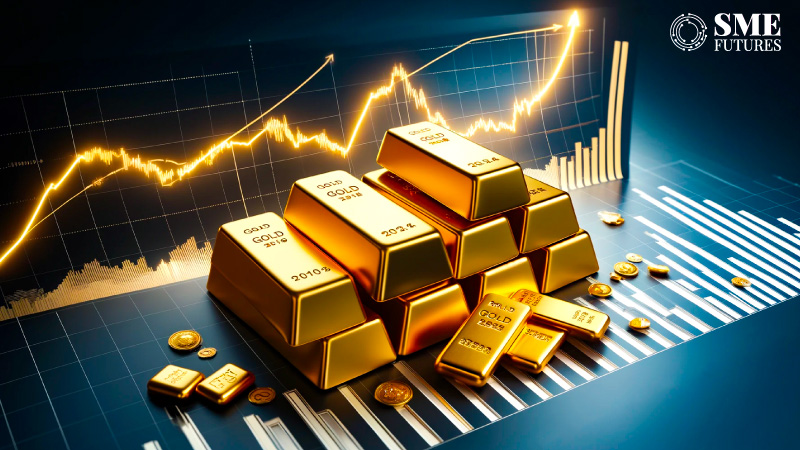Picture this!
In 2010, buying 1 kg of gold might have cost you roughly the same as a small luxury car. But in 2024, that same amount of gold could buy you a fancy yacht – talk about sailing on waves of gold!
Prices have gone up to Rs 74,000 from Rs 18,500 in 2010 for just 10 grams of gold. It’s a 300% increase!
Indeed, 2024 is witnessing a gold rush.

Geopolitical tensions impacted prices
Gold prices are soaring, and geopolitical tensions are adding fuel to the fire. From the Middle East showdowns to the Ukraine-Russia saga, it’s like a never-ending episode of geopolitical reality TV. It’s like the world has hit the panic button, and everyone is rushing to grab a piece of the golden pie.
Investors are flocking to gold like it’s the ultimate safety net in a world of economic tightropes and political minefields. But why the gold rush? Well, for starters, gold has this aura of invincibility—it’s been the go-to asset when things get dicey. And let’s not forget, gold isn’t just some abstract concept on a screen; it’s the real deal, a tangible asset you can hold onto when the world feels like it’s spinning out of control. In short, it’s a safe haven asset.
Colin Shah, MD of Kama Jewellery, sums it up perfectly, saying “Gold has continued its northward movement and is scaling up. Thanks to geopolitical tensions, gold provides a meaningful hedge in an uncertain economic environment.”
Dilip Dassani, Partner at Dassani Brothers, agrees, pointing out that when the world feels like it’s spinning off its axis, gold is the anchor we all cling to for stability. “Amidst the current geopolitical tensions, gold remains a sought-after safe haven asset, attracting institutions and individuals seeking stability amidst uncertainty,” he says.
Central banks buying gold
Central banks are wielding their financial might to propel gold prices to stratospheric heights, igniting a global frenzy in the precious metal market. With a voracious appetite for gold, major players like China and Russia and even India are leading the charge, snapping up bullion at a blistering pace. Goldman Sachs’ analyses paint a vivid picture: between 2022 and 2023, central banks devoured a staggering 1,060 tonnes of gold, dwarfing the 509 tonnes acquired in the preceding years from 2016 to 2019. This gold rush isn’t confined to a few nations; it’s a seismic shift as countries like China pivot away from the dominance of the American dollar, while others like Poland fortify their gold reserves.

But what’s driving this frenzied buying spree? Dilip Dassani answers, revealing a strategic manoeuvre by central banks to diversify their investment portfolios and shield themselves from the vulnerabilities of single-currency dependence, particularly the American dollar.
“When central banks enter the gold market, their significant purchases drive up prices and limit supply, leading to increased demand. This dynamic creates artificial scarcity, bolstering gold prices further. Additionally, banks strategically manage supply by reducing output, intensifying market demand. Consequently, gold prices surge as banks’ large-scale acquisitions reshape market dynamics,” he explains.
This phenomenon underscores the pivotal role central banks play in influencing gold prices and shaping market sentiment. As a result, fluctuations in gold prices often reflect broader economic trends and geopolitical developments, making them a key indicator for investors and stakeholders in the jewellery and gold industry. Understanding these market dynamics is crucial for industry participants to navigate and capitalise on evolving trends in the gold market, he adds.
Indeed, the central banks’ gold-buying spree isn’t just about shoring up reserves; it’s a high-stakes game that reverberates across global economies and geopolitical landscapes.
Impact on jewellery stakeholders
“Currently, the gold market is experiencing ample supply with limited demand due to the ongoing increase in prices. Consumers are holding off on purchasing gold jewellery as they anticipate a decrease in prices. This hesitancy has resulted in a surplus of available supplies in the market,” says Dassani.
Indian jewellery stores, typically bustling with customers in the lead-up to the summer wedding season, are now experiencing a noticeable hesitation among shoppers. For jewellery stakeholders it’s a challenge. Retailers too are facing a dip in revenue.
“Despite witnessing high turnover in rupees, there’s a noticeable decline in the volume of gold sold, particularly among lower and middle-income consumers who are deterred by the soaring prices. Consequently, the production costs have surged, directly impacting profit margins, as the increased cost of gold wastage in production further intensifies this challenge. To address these issues, we have refined our jewellery-making process to optimise margins while continuing with our quality standards. We have introduced creative naming techniques. This leads to a shift in consumer preferences as they seek to maintain budgetary constraints for weddings and festivities,” Dassani adds.
To satisfy developing consumer demand, jewellery stakeholders are also incorporating customer feedback, asking for their specific requirements and demands.
“This allows jewellery manufacturers to modify production patterns and design accordingly on a daily basis. By staying updated with the market dynamics and actively engaging with our clientele, we ensure that our jewellery designs align with their preferences and financial considerations. This agile approach enables us to adapt swiftly to changing market trends while delivering value and satisfaction to our customers,” he says.
The imbalance between supply and demand underscores the challenge faced by the jewellery and gold industry in stimulating consumer interest amidst fluctuating market conditions. As gold prices continue to rise, it’s crucial to adapt strategies to maintain profitability in this volatile market environment. Staying agile and receptive to market fluctuations will be key to navigating the ongoing challenges posed by geopolitical instability and its impact on gold prices.
Consumers shift to alternative jewellery
The current lack of stability in geopolitics is significantly affecting consumer pricing and confidence in the jewellery and gold industry. Consumers are instead seeking smaller, lighter items. As a result, demand is shifting towards alternative options, with silver jewellery emerging as a popular choice.
Dassani informs us that they too have already strategically pivoted towards lighter jewellery designs and have incorporated coloured gemstones to create the illusion of size while reducing production costs.
“Over the past few years, there has been a notable increase in demand for silver jewellery. This indicates a trend away from traditional gold purchases. This shift in consumer preference underscores the need for industry players to adapt their offerings and marketing strategies to cater to evolving demand. By recognising and responding to these changing market dynamics, businesses can position themselves to effectively meet consumer needs and maintain competitiveness in the jewellery and gold industry,” he avers.
Ancillary stakeholders in flux
The ripple effects of the surge in gold prices are being felt beyond just the glittering world of jewellery. In fact, the geopolitical tensions have not only impacted jewellery sales in India but have also engendered changes in ancillary sectors like safe deposit storage.
Enterprising entities like Aurm, which caters to individuals seeking secure storage solutions for their precious assets is witnessing new trends.
Ganesh Balakrishnan, Co-founder of Aurm, sheds light on the evolving trends in customer behaviour and Aurm’s response to the rising demand for secure storage solutions, saying, “During periods of market volatility, customers typically prefer to invest their money in gold, which is a much safer savings instrument. The value of gold has appreciated by 40% since 2022, making it a preferred investment option for Indians.”
Balakrishnan further notes, “As the price of gold increases, the demand for safe storage becomes more important and urgent. Our sales conversion has surged to almost 80%, with 8 out of 10 customers subscribing to our lockers.”
Aurm has implemented stringent security measures to address heightened economic uncertainty. “All of Aurm’s safe deposit vaults are protected with state-of-the-art security measures, ensuring the safety of our customers’ assets,” he emphasises.
Furthermore, Aurm is proactively exploring additional services to mitigate the impact of rising gold prices on its customers. “We are in talks with jewellery brands to offer save-and-buy schemes and loyalty rewards for customers, providing added value during these challenging times. And we expect to launch it soon,” Balakrishnan reveals.
Although the safe deposit locker concept is not new in India, there is a significant supply-demand gap for safe deposit locker facilities in urban India. There are 60 million affluent Indians, but only 6 million lockers available across all banks and private players. This means that 54 million Indians don’t have access to a locker to store their valuables! In a country that has 12% of the world’s gold in private households (Indians have 25,000 tons of gold in their homes), the lack of safe storage options presents a large market opportunity.
Is the price increase temporary?
Goldman Sachs says that the prices will continue to skyrocket. Reassessing its gold prices predictions, it says that the price surge cannot be solely explained by traditional macroeconomic factors like real interest rates, growth projections, and currency strength. Despite this, the bank remains optimistic about gold’s prospects, citing ongoing demand from central banks, including the People’s Bank of China (PBOC), and increasing interest from Chinese investors.
Stakeholders in India too feel the same about further price surges, although with variations, due to the ongoing geopolitical tensions.
Over the past two years, gold prices have steadily amplified from $400 to $500, indicating a determined trend rather than a temporary spike. This trajectory suggests that the market anticipates further geopolitical turmoil, driving up demand for gold as a safe haven asset. Until these geopolitical tensions subside, we can expect gold prices to remain elevated.
As such, industry players must remain vigilant and adapt their strategies to navigate the volatile gold market landscape effectively. By monitoring market trends and consumer behaviour closely, businesses can position themselves to capitalize on opportunities and mitigate risks in the ever-changing jewellery and gold industry.











